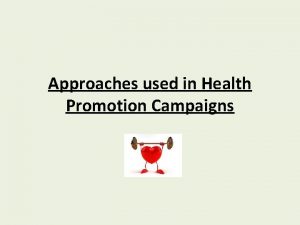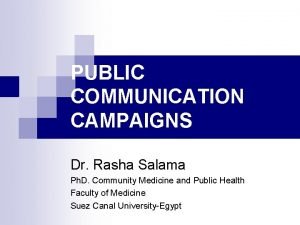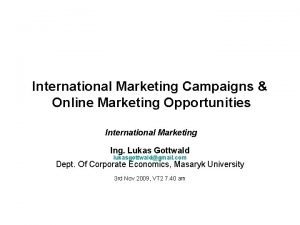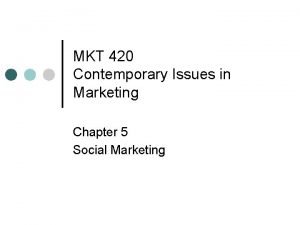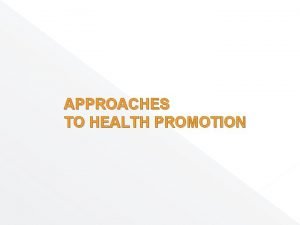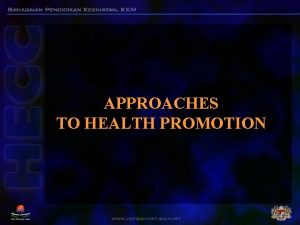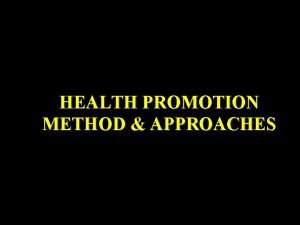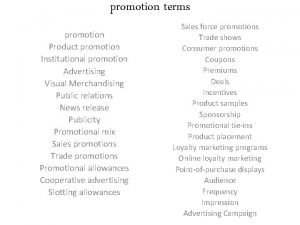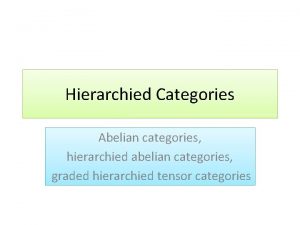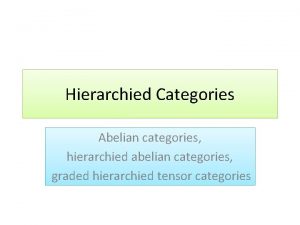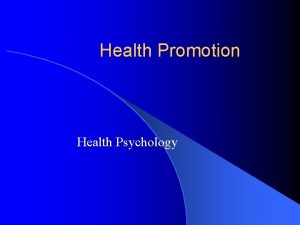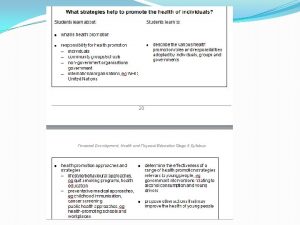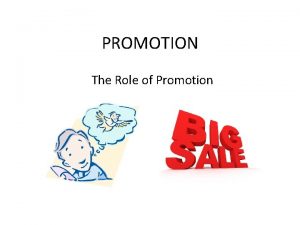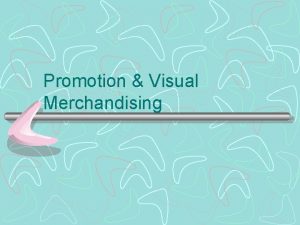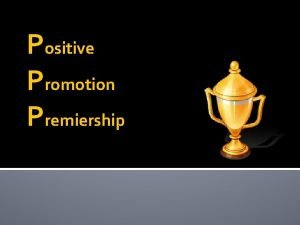Approaches used in Health Promotion Campaigns 5 categories

















- Slides: 17

Approaches used in Health Promotion Campaigns

5 categories of Approaches to Health Promotion 1. 2. 3. 4. 5. Medical or Preventative approach Empowerment approach Behaviour change approach Educational approach Social Change approach

The Medical Approach • The medical approach can be aimed at whole populations or at a high risk group e. g. smokers • It focuses on activity aimed at reducing morbidity, (the proportion of sickness or a specific disease in a geographical locality) and premature mortality. • This approach values preventive medical procedures and the medical profession’s responsibility to ensure that the patients comply.

• The medical approach to health promotion believes in the importance of medical interventions in preventing ill health and premature deaths • This approach to health promotion focuses very much on the absence of disease – not positive health • The medical approach is often criticised for failing to acknowledge social and environmental aspects of health • Popular because it is cheaper in the short term

The classification of Medical health promotion activities 1) Primary- aimed at reducing risks to the entire population. Prevention of the onset of disease through risk education. 2) Secondary- aimed at reducing risk factors for people already at risk. Prevention of disease progression through screening etc. 3) Tertiary- aimed at people suffering from illhealth, social disease or disability.

Key term • Preventative: • Preventative health promotion focuses on preventing the onset of disease • This is often done by encouraging immunisation, screening , healthy eating and exercise • The medical model relates to preventative health promotion

The Empowerment Approach • Empowerment: • Empowerment means; ‘to give power or authority to make decisions and take control over one’s own life’ • Focuses on enabling people to express their concerns, and gain skills and knowledge to do something about it. Bottom up • Looks at wider factors impacting health; instead of just focusing on specific medical concerns

• This approach is very much in support of the WHO 1986 definition of health promotion: • ‘Enabling people to gain control over their lives’ • Client centred • The health promoter should act as a catalyst, and then withdraw from the situation • Empowerment has been used to describe a way of working which increases people’s power to change their ‘social reality’

• This is more about working in partnership with clients, about getting them to identify what they want to work on. About getting them to make their own decisions and choices. • The health promoter’s role is to be a facilitator. • Self empowerment of the client is central. • The clients are valued as equals who have much to contribute and a right to determine their own future.

The Behaviour Change approach • The aim is to change people’s individual attitudes and behaviours, so they take on a ‘healthy lifestyle’. • E. g. Smoking cessation programmes, exercise through prescription or referral schemes, weight loss through Weight Watchers referral or the School Fruit and Vegetable scheme. • The health promoter believes that this lifestyle change is in the client’s best interests and feels responsible to encourage it.

• Person must be ready to take action – or it will not be effective • Very popular with policy makers • Mass media communication • The expert gives advice to the lay person • Not always successful

The Educational Approach • Knowledge and information are key to this approach. • Leaflets • The main aim of this approach is to develop the necessary understanding and skills so that people can make informed lifestyle choices • The educational approach does not try to persuade change in a particular direction

• It assumes that knowledge will bring about a change in attitude and then change behaviour • Education is intended to have an outcome. • The outcome will be the client’s choice and it may/may not be one the health promoter would have selected. However, this approach respects the individual’s right to choose. • The promoter sees it as their responsibility to approach those health issues they see as being in the client’s best interests.

• Information and even the desire to change is often not enough to actually do so • Social factors • Environmental factors

The Fear strategy Fear: • Many health promotion campaigns are designed to elicit fear • Fear is most likely to be effective if the campaign allows for the desired behaviour to be reinforced by a reduction in the level of fear • This is what you can do…

The societal change approach • In this approach the aim is to make changes to the physical, social and economic environment in order to improve the health of the people who live in it. • It’s focus is on changing the health environment rather than the lives of the people who live in it. • Government level – make the healthy choice a realistic option for most people.

Further reading for references • Ewles and Simnett ‘Promoting Health: A Practical Guide’ (page 34) • ‘Foundations for Health Promotion’ by Naidoo and Wills (page 67)
 Ewles and simnett 5 approaches to health promotion
Ewles and simnett 5 approaches to health promotion Difference between health promotion and health education
Difference between health promotion and health education Health maintenance and promotion
Health maintenance and promotion Pcb 3703c ucf
Pcb 3703c ucf Public communication definition
Public communication definition Com3701
Com3701 International marketing campaigns
International marketing campaigns Informed delivery campaigns
Informed delivery campaigns Informed delivery multiple residents
Informed delivery multiple residents What is strategic brand communication
What is strategic brand communication 420 marketing campaigns
420 marketing campaigns Fast food campaigns
Fast food campaigns Categories used to group different types of literary work
Categories used to group different types of literary work A material's ability to allow heat to flow is called _____.
A material's ability to allow heat to flow is called _____. Public health approaches
Public health approaches Communication channels used in sales promotion
Communication channels used in sales promotion Communication channels used in sales promotion
Communication channels used in sales promotion Definisi promkes
Definisi promkes
